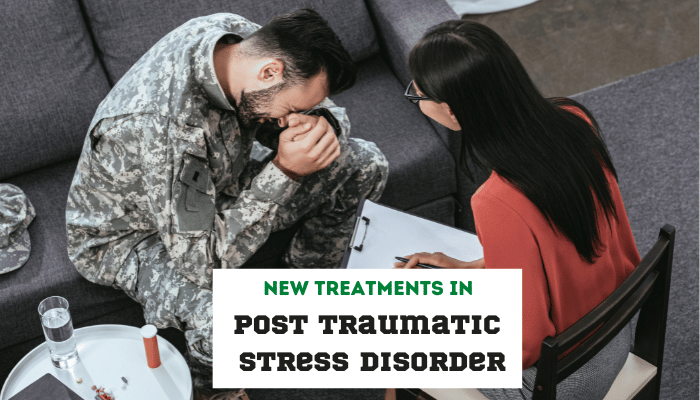New treatment for post traumatic stress disorder are providing promising results. These treatments are aimed at helping individuals identify and process the traumatic event, reduce their symptoms, and learn healthy coping skills. There is also increasing interest in the use of technology such as virtual reality, computer-assisted therapy, and Ketamine like therapy to help with PTSD symptoms.

Cognitive Behavioral Therapy (CBT)
Cognitive Behavioral Therapy (CBT) is an evidence-based form of psychotherapy that has been proven to be effective in treating symptoms of Post-Traumatic Stress Disorder (PTSD). CBT works by helping individuals to identify, challenge, and modify the thoughts and behaviors that may be contributing to their distress. CBT is a collaborative process between the therapist and the person seeking treatment. The therapist helps the person to identify and modify problem thoughts and behaviors as well as to learn new skills to cope with their PTSD symptoms.
How it works ?
In CBT for PTSD, the therapist helps the person to identify and change patterns of thinking and behavior that are contributing to their distress. The therapist helps the person to recognize how their thoughts and beliefs about the traumatic event may be contributing to their current problems. He then helps the person to develop new, healthier ways of thinking and responding to the traumatic event. The health professional also helps the person to develop coping skills and strategies (e.g., relaxation techniques, problem-solving skills, etc.) to reduce distress and better manage their PTSD symptoms.
Ketamine Therapy
Ketamine therapy for PTSD is a relatively new treatment for post-traumatic stress disorder (PTSD). A mental healthcare service provider based in Florida, USA, claims that latest therapy is effective in reducing symptoms of anxiety, depression, and intrusive memories. In addition, studies have suggested that ketamine may be able to reduce the risk of suicide in those with PTSD. The mechanism of action behind ketamine’s effectiveness is still being studied, but it is believed that the drug helps to block glutamate receptors in the brain, leading to a decrease in fear and other symptoms associated with PTSD.
How it works ?
Ketamine therapy for PTSD is typically administered intravenously or subcutaneously, although it can also be taken orally. The dose and frequency of ketamine treatment depends on the individual’s symptoms and response. Generally, ketamine is administered in the form of an infusion, where low doses are given over a period of several hours. The effects of ketamine therapy last for several hours, and can last up to several weeks with regular sessions.
Ketamine therapy for PTSD is considered a safe and effective treatment option for those with PTSD. However, it is important to be aware of potential side effects that may occur, including nausea, blurred vision, dizziness, and increased heart rate. In addition, ketamine can be abused, so it is important to talk to a medical professional before starting this treatment.
EMDR Therapy
Eye Movement Desensitization and Reprocessing (EMDR) is an evidence-based psychotherapy for treating post-traumatic stress disorder (PTSD). The goal of EMDR is to help people reprocess and integrate traumatic memories[1] so that they no longer have a negative effect on their daily life. EMDR utilizes bilateral stimulation, such as eye movements, tapping, or sound, to help the brain reprocess trauma memories. This type of therapy is believed to help people process memories in the same way that the brain naturally processes memories, allowing the memories to be integrated and stored in a more adaptive way. Through EMDR, people are able to gain insight, acceptance, and a sense of resolution in relation to their traumatic memories. This can help reduce symptoms of PTSD, such as intrusive thoughts, flashbacks, nightmares, anxiety, and depression.
How it works ?
During this process, the person is encouraged to focus on the traumatic memory while thinking of a positive, or adaptive thought. The therapist will then ask the person to report any changes in their thoughts, feelings, or bodily sensations. This process is repeated until the traumatic memory is reprocessed, and the person is no longer experiencing distress when thinking about the event.
MDMA-Assisted Psychotherapy
MDMA-assisted psychotherapy is a type of psychotherapy that involves the use of MDMA as an adjunct to psychotherapy. Its purpose is to facilitate the psychotherapeutic process and reduce fear and defensiveness, allowing deeper exploration of difficult-to-access material. MDMA-assisted psychotherapy is currently being studied as a potential treatment for post-traumatic stress disorder (PTSD).
Although MDMA-assisted psychotherapy is a promising treatment for PTSD, further research is needed to determine its safety and efficacy. If the results of future trials are positive, MDMA-assisted psychotherapy could be an effective treatment for people with PTSD.
How it works ?
During the session, the patient can feel more open to exploring their feelings and can be better able to access memories and emotions that have been blocked out or difficult to access. The therapist may ask the patient to focus on certain experiences or memories, allowing them to process them in a more positive way. The MDMA also helps to reduce fear, anxiety, and stress, allowing the patient to feel more relaxed and open to the therapeutic process. After the session, the patient is usually encouraged to process and integrate their experience into their everyday life.
Stellate ganglion block
A stellate ganglion block is a type of nerve block used to treat pain and other symptoms resulting from trauma or injury in the sympathetic nervous system. It is commonly used to treat conditions such as complex regional pain syndrome (CRPS), post-traumatic stress disorder (PTSD), and other forms of chronic pain.
How it works ?
Th process involves injecting a local anesthetic into the stellate ganglion, which is a group of nerves located in the neck near the collarbone. The injection blocks the transmission of pain signals to the brain, providing relief from pain and other symptoms. While this procedure is not a cure for PTSD, it may help reduce some of the symptoms associated with it.
Virtual reality
Virtual reality (VR) has been used as a therapeutic tool to treat post-traumatic stress disorder (PTSD) in recent years. VR therapy has been found to be effective in reducing the symptoms of PTSD, such as intrusive thoughts, nightmares, and other forms of psychological distress.
How it works ?
VR therapy typically involves a patient being exposed to a simulation of their traumatic event in a safe, controlled environment. Patients can then work through the experience with a therapist, who can help them to process their emotions and reactions in a safe way. VR therapy has been shown to be more effective than traditional talk therapy for PTSD, and it has fewer side effects. Additionally, it may be easier for some patients to process their trauma in a virtual reality environment, as it can provide a sense of control and detachment.
Equine therapy
Equine therapy for post-traumatic stress disorder (PTSD) is a type of experiential therapy that uses horseback riding and other activities with horses to help individuals with PTSD. This therapy has been found to help reduce PTSD symptoms such as anxiety, flashbacks, and avoidance, as well as improve physical health, social functioning, and overall quality of life. Through this type of therapy, individuals learn to trust themselves and others, as well as develop patience, understanding, and self-acceptance.
How it works ?
During equine therapy for PTSD, individuals work on developing a connection with the horse, learning how to listen to their body language and respond to their cues. They also learn to control their emotions and take responsibility for their actions. This type of therapy helps those with PTSD gain insight into their behavior and teaches them how to manage their emotions more effectively. It also helps them to identify and manage triggers that may trigger their PTSD symptoms.

Lifebing is driven by an unrelenting passion for promoting health and well-being, our team is wholly committed to curating exceptional content and immersive experiences.
